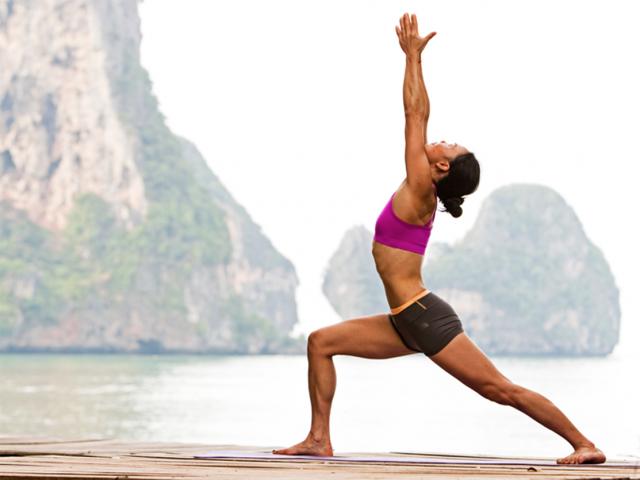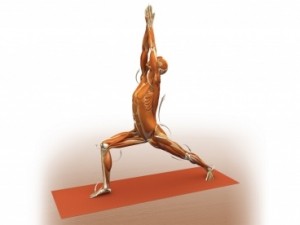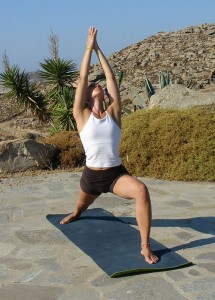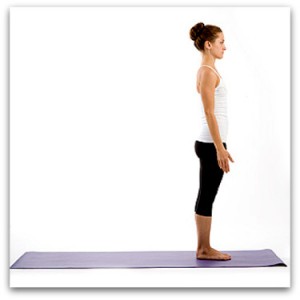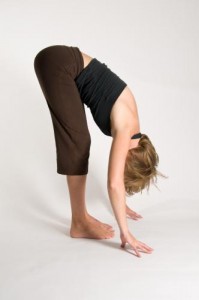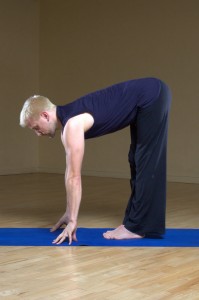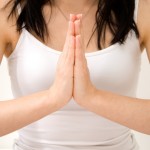• Begin in Tadasana
• Step the right foot far forward so that when you bend the right front leg it will be at a right angle
• Then straighten both legs
• The back foot should not be directly behind the front foot, the inner aspect of the left heel should be in line with the inner part of the front foot as this enables the hips to be aligned and facing forward
• Arms are relaxed down the sides of the body
• On the inhalation, raise the arms up alongside the head and only, if possible, in line with the ears
• On the exhalation, bend the front right leg to 90 degrees
• The right knee should be directly above the right ankle and in line with the toes, the toes pointing forward
• The back left leg should be as straight as is possible and comfortable
• Consciously drop the tailbone down to the mat
• If flexibility allows, the back foot should be as flat as possible on the floor
• The head and the chest should face the same direction as the right knee
• Feel that you can stretch the mat apart between the feet i.e. pushing front foot down & forward and back foot down and backward
• Breathe naturally and hold for 5 breaths as a beginner and 8 to 10 breaths or more for a more advanced practitioner
• Release on the inhalation by releasing the arms down and straightening the front right leg
• On the exhalation step the feet together back to Tadasana
• Repeat the asana on the left side of the body for the same duration of time.
Counterpose / Pratikryasana:
• Tadasana, (feet together) or
• Samasthiti, (feet hip distance apart) or
• Uttanasana
• Ardha Uttanasana, (back in “Table top” position)
Benefits:
• Tones and strengthens the leg muscles
• Opens and expands the chest facilitating breathing
• Releases stiffness and tensions between the shoulders, in the neck and in the back
• Corrects round and drooping shoulders
• Tones the abdominal area by reducing fat around the hips.
Cautions & Modifications:
• If one is prone to tight shoulders, take the raised arms further away from the head i.e. a wide “V”, or turn the armpits to face further forwards
• Do not raise the arms upright if suffering from High Blood Pressure or any Heart Ailments rather rest the hands on the hips or bring the palms in Anjali Mudra, (prayer position), and do not hold the pose for too long, 3 to 5 cycles of breaths should suffice.
• With any sacral or lumbar area conditions in particular, proceed into the asana cautiously and do not over extend in the lower back, instead consciously drop the tailbone down releasing any arch in the lower back
• If one experiences very tight quadriceps or thigh muscles and finds keeping the back foot as flat as possible too challenging on the muscles, curl the back toes under and raise the heel off the floor turning the foot to face forward – this will facilitate the hips facing forward more and release the feeling of discomfort on the tight quadriceps. Bearing in mind that being on the back toes requires more concentration as balance plays more of a role in this variation.
Only hold the pose for as long as is comfortable and breathing as naturally as possible and allowing the abdomen to breathe freely.
Remember to be mindful of:
Sthira Sukham Asanam – Steadiness and Comfort in the Pose so remember to be present with the breath and listen to the body. Where you are in your practice, is exactly where you are meant to be – that is your Yoga.
Enjoy!
Love and Light,
Juanita.
